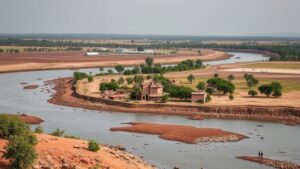Investigating the hidden remnants of Vinland, the Viking settlement in North America.
Investigating the Hidden Remnants of Vinland, the Viking Settlement in North America
The Viking settlement known as Vinland represents a fascinating chapter in the history of Norse exploration. While often overshadowed by other historical narratives, the exploration and settlement activities undertaken by the Vikings in North America during the late first millennium are both significant and intriguing.
A Brief Overview of Vinland
Vinland is widely believed to be located in what is now Newfoundland, Canada. The settlement was first described in the sagas of the Icelandic Vikings, particularly in The Saga of the Greenlanders and Eirik the Reds Saga. These narratives detail voyages led by Leif Erikson around the year 1000 AD, which were aimed at exploring lands west of Greenland.
- Leif Eriksons expedition landed on the shores of Vinland circa 1000 AD.
- It is characterized by wild grapevines, leading to its naming as Vinland or land of wine.
Key Archaeological Discoveries
The most significant archaeological evidence of Vinland was discovered at LAnse aux Meadows, a UNESCO World Heritage Site located at the northern tip of Newfoundland. Excavations at this site, which took place in the 1960s, uncovered the remnants of eight Norse structures, believed to be the oldest known European settlement in North America.
- The site includes longhouses, fire pits, and workshops, all indicative of Norse construction techniques.
- Artifacts such as iron tools, pottery, and a distinctive type of soapstone suggest the settlers engaged in both domestic and artisanal activities.
Understanding Norse Settlement Patterns
The Viking approach to settlement often involved establishing temporary camps rather than permanent villages. This reflects their need for resources such as timber, furs, and food, and suggests that they were more exploratory than agricultural. Similar patterns can be seen in other areas of Norse expansion, including Greenland.
- Vikings used a combination of maritime and terrestrial routes to optimize resource gathering.
- Their knowledge of sailing and navigation was advanced, enabling them to undertake far-reaching voyages.
Vinland in the Context of Viking Exploration
Vinland is part of a broader narrative of Viking exploration that spanned across Europe, Asia, and North America. This illustrates not just a quest for land, but also for trade and interaction with various cultures. The Vikings’ journeys established them as formidable explorers, influencing trade routes and cultural exchanges long before Columbus’ arrival in 1492.
For example, the Viking trade network extended as far as the Byzantine Empire and the Islamic world, emphasizing their diverse interests and capabilities. Their ability to adapt to varying environments is reflected in their colonization strategies, which were often temporary yet resourceful.
Modern Investigations and Challenges
While LAnse aux Meadows has provided substantial evidence of Viking presence in North America, ongoing research seeks to uncover more about the extent and nature of Vinland. Archaeologists face several challenges, including the preservation of sites over time and determining the accurate dating of artifacts.
- Non-destructive methods like ground-penetrating radar are increasingly used to locate buried features without excavation.
- Collaborative efforts between North American and Scandinavian archaeologists are essential for a more comprehensive understanding of Viking exploration.
Conclusion: The Legacy of Vinland
The investigation into the hidden remnants of Vinland not only enhances our understanding of Viking exploration but also contributes to the broader narrative of human migration and cultural exchange. As we uncover more about sites like LAnse aux Meadows, we gain insights into the lives and motivations of these remarkable seafarers.
As historical methodologies and technologies evolve, so too does our understanding of this extraordinary episode in North American history. For those interested in the legacy of human exploration, the story of Vinland serves as a compelling reminder of how interconnected our worlds past truly is.
To further engage with this topic, consider visiting archaeological sites or participating in local historical societies dedicated to preserving the Viking legacy. Staying informed about ongoing research and discoveries will continue to illuminate the intricate tapestry of exploration woven throughout history.


